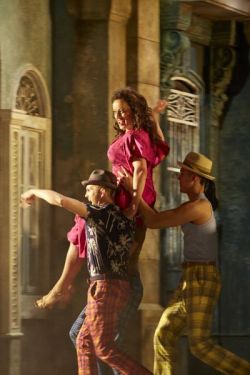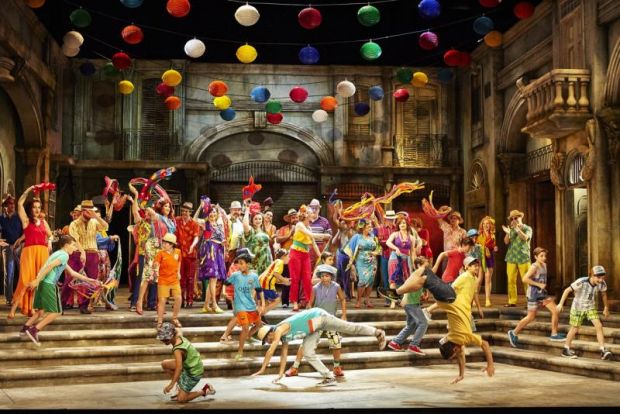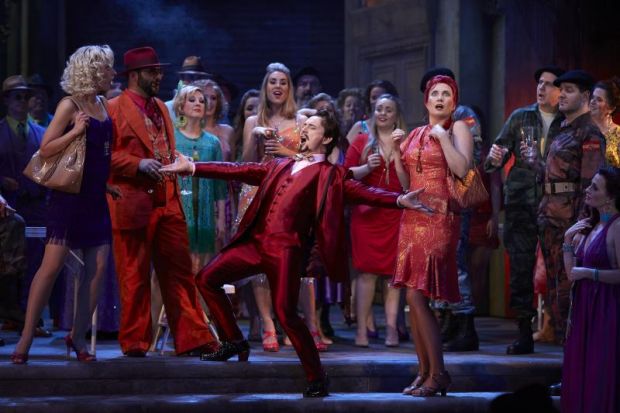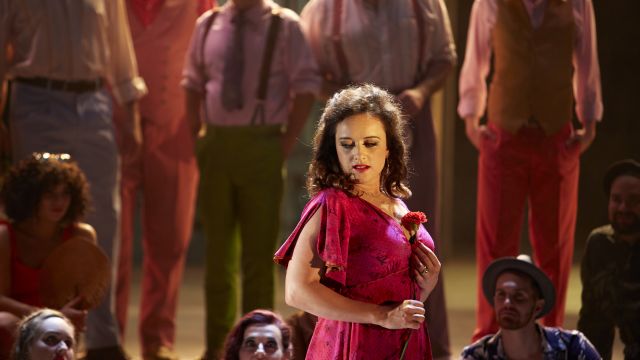Carmen
By transporting this production of Carmen to “somewhere resembling today’s Havanna”, director John Bell and his design team bring the opera into a setting that heightens the heat and spirit of the story, and takes the music of the famous “Habanera” back to its country of origin.
Michael Scott-Mitchell’s set of imposing, but crumbling Spanish architecture that suggests the romantic image of a Cuba emerging from years of isolation, is an apt setting for story that involves soldiers and gypsies and bullfights – and Teresa Negroponte’s colourful and suggestive costumes accentuate the credibility of taking the opera to a contemporary setting.
The music of Carmen transcends time because of the diversity of music, which George Gershwin described as “almost a collection of song hits”. The story, based on a novella written by Prosper Merimee in 1845, is hardly what the audiences of 1875 expected: a beautiful, flirtatious gypsy girl tempting a loyal soldier from his duties and his home-town sweetheart; a group of factory girls helping smugglers to escape with their contraband to the mountains; cheeky street urchins mocking soldiers.
 In fact, critics denounced the original production as “immoral and superficial”. But the rich variety of musical styles with which Bizet chose to bring the story to life transcended such objections, making its overture and its arias – the “Toreador Song”, the “Habanera” – some of the most loved and recognised classical pieces.
In fact, critics denounced the original production as “immoral and superficial”. But the rich variety of musical styles with which Bizet chose to bring the story to life transcended such objections, making its overture and its arias – the “Toreador Song”, the “Habanera” – some of the most loved and recognised classical pieces.
As Carmen and Don Jose, Clementine Margaine and Yonghoon Lee find all the initial romance and impending drama of the love story that is Carmen.
Margaine adds Opera Australia to her nine international performances in the title role. She is suggestively flirtatious as Carmen, joining the dance sequences with provocative fluidity whilst still finding the richness of the changing range and tone of the music – the light, brightness of early arias contrasting with the dark depths of the tarot card aria and the final dramatic duet with a despairing Don Jose.
Yonghoon Lee is impressive as the love-lorn Don Jose, bringing dramatic realism to his characterisation and Bell has directed his vision of Don Jose to match the depth and power of Lee’s voice and acting. Thus this Don Jose is more passionate in the “Flower Song” and more evocatively tragic in the gripping final arias.
Natalie Aroyan is beautifully guileless as Micaela, finding the haunting simplicity of Bizet’s musical interpretation of the uncomplicated country life – and love – Jose will leave behind as he succumbs to Carmen’s charm.
The flamboyant bullfighter Escamillo is performed with by Michael Honeyman who, dressed in lustrous red satin, finds all of the pace and splendour of the “Toreador Song” with lively – and handsome – panache.
 Adrian Tamburini as the duped lieutenant, Zuniga, and Jane Ede and Margaret Trubiano as the teasing gypsy fortunetellers, Frasquita and Mercedes, are backed by a large, talented and colourful chorus, who wear Negroponte’s sexy costumes with the same bright confidence with which they sing and dance. Choreographer Kelly Abbey has mixed modern dance styles to match Bell and Negroponte’s contemporary vision. The little hip-hop dancers in the chorus are no exception, their energy and style almost stealing their scenes.
Adrian Tamburini as the duped lieutenant, Zuniga, and Jane Ede and Margaret Trubiano as the teasing gypsy fortunetellers, Frasquita and Mercedes, are backed by a large, talented and colourful chorus, who wear Negroponte’s sexy costumes with the same bright confidence with which they sing and dance. Choreographer Kelly Abbey has mixed modern dance styles to match Bell and Negroponte’s contemporary vision. The little hip-hop dancers in the chorus are no exception, their energy and style almost stealing their scenes.
This production makes the most of this, the first of the ‘Verismo’ operas – those that portrayed “normal people in a realistic style”. By moving it into a Cuban-inspired modern setting, Bell has lost none of the power and pace of either the music or the story, rather he has accentuated the authenticity of the characters and their plights – and the on-going, universal appeal of Bizet’s ground-breaking opera style.
Carol Wimmer
Photographer: Keith Saunders.


Subscribe to our E-Newsletter, buy our latest print edition or find a Performing Arts book at Book Nook.

